It’s enough to make anyone need a sit-down with a cup of tea and a four-fingered chocolate wafer biscuit.
The confectionery multinational Nestlé has lost the latest round of its long-running battle with rivals Cadbury to trademark the shape of the KitKat bar in the UK. The court of appeal ruled that the four-finger design had “no inherent distinctiveness”.
After deliberating for months, the three appeals judges delivered their judgment on Wednesday in a 16,000-word ruling that found the KitKat shape was not a “badge of origin”.
“We are concerned here with ... the three-dimensional shape of a chocolate product, that has no inherent distinctiveness,” said Lord Justice Kitchin.
The ruling marks the latest stage in a bitter-tasting battle between Nestlé and Mondelēz, the US owner of Cadbury, that have been battling over the KitKat trademark for seven years.
Nestle’s appeal followed a UK high court ruling in January last year that blocked the trademark attempt. The European court of justice had previously found that the four-fingered shape, breaking apart with a snap, was not distinctive enough to merit a trademark and that such a designation would not comply with European law.
The ruling clears the way for competitors, including the major supermarkets as well as other confectioners, to produce their own copycat KitKats without fear of legal consequences.
But a Nestlé spokesperson indicated the Swiss firm was not necessarily prepared to give up, saying it was considering its next move. The company could potentially try to take the case to the UK supreme court.
“Nestlé is disappointed by the court of appeal judgment and is considering its next steps,” said the spokesperson. “KitKat is much loved around the world and its four-finger shape is well known by consumers. Nestlé’s four-finger shape has been granted trademark registration in many countries of the world, for instance Germany, France, Australia, South Africa and Canada, further protecting it from imitations.”
Following the appeal ruling, a Mondelēz spokesperson said: “As we have previously stated, we do not believe the shape of the KitKat bar should be protected as a trademark in the UK.”
The case turned on whether a the product’s shapewas sufficiently distinctive to the brand to prevent any other manufacturer using a similar format. Protected “shape marks” are not without precedent — Toblerone, which is owned by Mondelēz, has successfully trademarked its “zigzag prism” shape.
But the appeal judges found that while the four-finger shape might be “very well known” in association with KitKat, “that does not necessarily mean that the public have come to perceive the shape as a badge of origin such that they would rely upon it alone to identify the product as coming from a particular source.
“They might simply regard the shape as a characteristic of products of that kind or they might find it brings to mind the product and brand name with which they have become familiar.
“These kinds of recognition and association do not amount to distinctiveness for trademark purposes.”
The judges also noted that the chocolate bar’s shape had not been central to its marketing in recent years: “It has nothing, therefore, to do with the informed choices that consumers make between similar products.”
The judges heard that Nestlé had spent between £3m and £11m a year advertising and promoting KitKats between 1996 and 2007. More than 40m were sold in Britain in 2010.
“The appeal court’s ruling indicates that shape marks are going to be increasingly difficult to obtain,” said Guy Wilmot, partner who specialises in intellectual property law at Russell-Cooke.
“The court were ... concerned that if they granted the trade mark, Nestlé would have a potentially permanent monopoly on the four-finger shape, which they felt would be unfair given that KitKat had never used the shape alone to promote KitKats.”
Clare Jackman, an intellectual property lawyer at Norton Rose Fulbright, said the fact the two multinationals were prepared to battle through the courts for so long showed the value of what was at stake.
“Trademarks are very important and valuable business assets. They confer monopoly rights, so I can see entirely why Nestlé thought, ‘our four-finger bar KitKat has been around for ages, let’s register it, because we can stop anyone from producing a bar in four fingers’”, she said.
“It is typically brand owners in this space that will spend the money and push the boundaries, in trying to get as much protection as possible, because at the end of the day trademarks can potentially last forever, so it really is a signficant monopoly right.”
Asked if she could foresee a challenge in supreme court, Jackman said: “I’m not going to rule it out, because I think these are two brand owners who are prepared to push this as far as it can go.”
The four-fingered battle is not the only protracted legal disputes between the two confectioners. In 2004, Cadbury attempted to trademark the shade of purple it uses for its Dairy Milk bars, registering Pantone 2685C in a move that was initially successful before the court of appeal backed Nestlé challenge in 2013. An attempt last year by Cadbury to resurrect an earlier trademark on the colour was rejected by the high court.
The first KitKat-type bar was sold in Britain by Rowntree in 1935, when it was called Chocolate Crisp, and the shape has changed little since then. Nestlé acquired Rowntree in 1998.
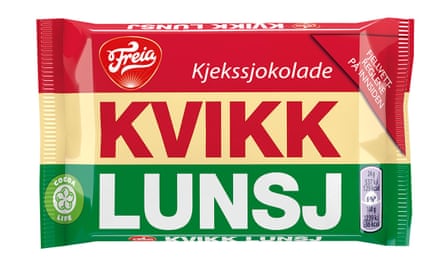
A lookalike called Kvikk Lunsj, translated as “quick lunch”, launched in Norway in 1937 and is available in some UK shops.
This article was amended on 18 May 2017. The judge’s ruling was not a “badge of origin”, a previous version said the judge’s ruling was not a “badge or origin”.
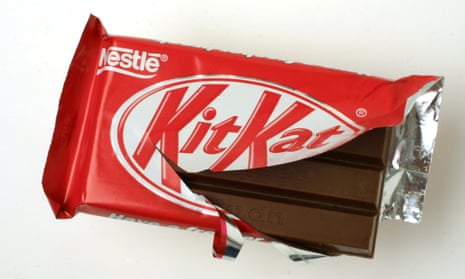




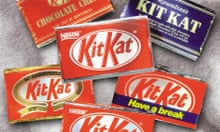
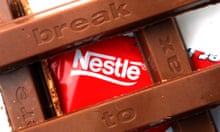
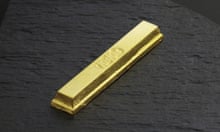
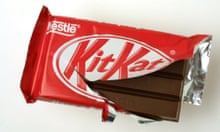
Comments (…)
Sign in or create your Guardian account to join the discussion